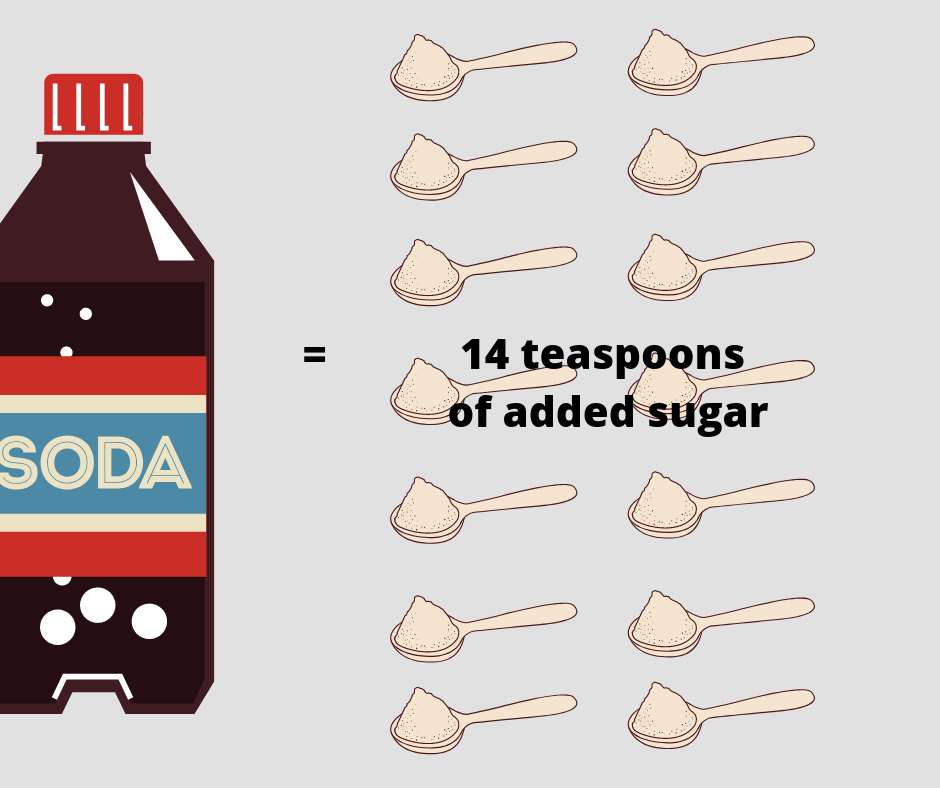The New Year is the perfect time to start thinking about your health goals. Your diet makes a big difference in your health. This week I wanted to focus on added sugar. A diet high in added sugars causes spikes in blood sugar, energy fluctuations, and weight gain. For those who have type-2 diabetes or who are pre-diabetic, avoiding added sugar can help you reach your A1C goals.
 Some healthy sugars are naturally in foods like fruits, starchy vegetables, milk, and grains. Other foods have many added sugars that food companies add during processing to make foods taste sweeter and more appetizing. Foods that have unhealthy amounts of added sugar include sugar-sweetened beverages, baked goods, desserts, candies and even snack foods such as yogurt and granola bars.
Some healthy sugars are naturally in foods like fruits, starchy vegetables, milk, and grains. Other foods have many added sugars that food companies add during processing to make foods taste sweeter and more appetizing. Foods that have unhealthy amounts of added sugar include sugar-sweetened beverages, baked goods, desserts, candies and even snack foods such as yogurt and granola bars.
The American Heart Association suggests limiting added sugar to 9 teaspoons (36 grams) for men, and 6 teaspoons (25 grams) for women. To put things in perspective, a single 20 ounce bottle of soda contains about 14 teaspoons of sugar and the average chocolate bar contains 6 teaspoons of sugar!
But choosing a healthy diet is easier said than done. The easiest food to access is often the unhealthiest: fast food, canned food, microwave meals, candy. To make matters worse, food that is marketed as ‘healthy,’ ‘natural,’ or ‘low in sugar,’ is not necessarily actually healthy.
This is where reading food labels comes in. Paying attention to what’s in your food will empower you to make the best decision. Food labels can be difficult to read, with fine print, percentage breakdowns, and deceptive serving sizes. Here are some tips for successfully and quickly navigating a food label in the store:
 Serving size matters. The serving size listed on a food label may be different from what you eat. If you eat twice the serving size listed on the label, you consume double the amount of sugar and other ingredients than listed.
Serving size matters. The serving size listed on a food label may be different from what you eat. If you eat twice the serving size listed on the label, you consume double the amount of sugar and other ingredients than listed.- Total sugars. Total sugars include both natural sugars and added sugars. So don’t pass up on nutritious foods that contain healthy natural sugars such as whole grain bread and peaches, which are great sources of fiber. Be mindful of ‘total sugars’ versus ‘added sugars’.
- Added sugars. Added sugars are unhealthy sugars that are added in addition to the natural sugars in the food. Is your strawberry yogurt healthy and full of only natural sugars? Likely not, some fruit flavored yogurts have as much added sugar as a candy bar.
- Ingredient list. The ingredient list orders ingredients by weight. So if one of the first few ingredients is sugar, take note. Family Medicine dietitian Lana Nasrallah says, “Keep in mind that added sugars go by many names, including sucrose, glucose, maltose, dextrose, high fructose corn syrup, concentrated fruit juice, agave nectar, and honey.” To read a list of common names of added sugar, select here.
Did you know?
- Fruit juice. Fruit juices are full of sugar and low in nutritional value compared to fresh fruit. A cup of apple juice contains almost 10 teaspoons of sugar, almost exactly as much as a can of soda. “As part of a healthy diet, trading sugary drinks for water and zero-calorie drinks can help you limit added sugar and calories, which may help controlling blood sugar and achieving a healthy weight,” says Family Medicine dietician Lana Nasrallah.
- Whole foods. One way to avoid eating too much added sugar is to eat whole foods such as vegetables, fruits, lean-meats, and nuts.
You and your doctor can work together to set your health goals. If you want to focus on healthy eating to meet your goal, Family Medicine has a dietitian who can examine your eating habits and make a plan with you.
